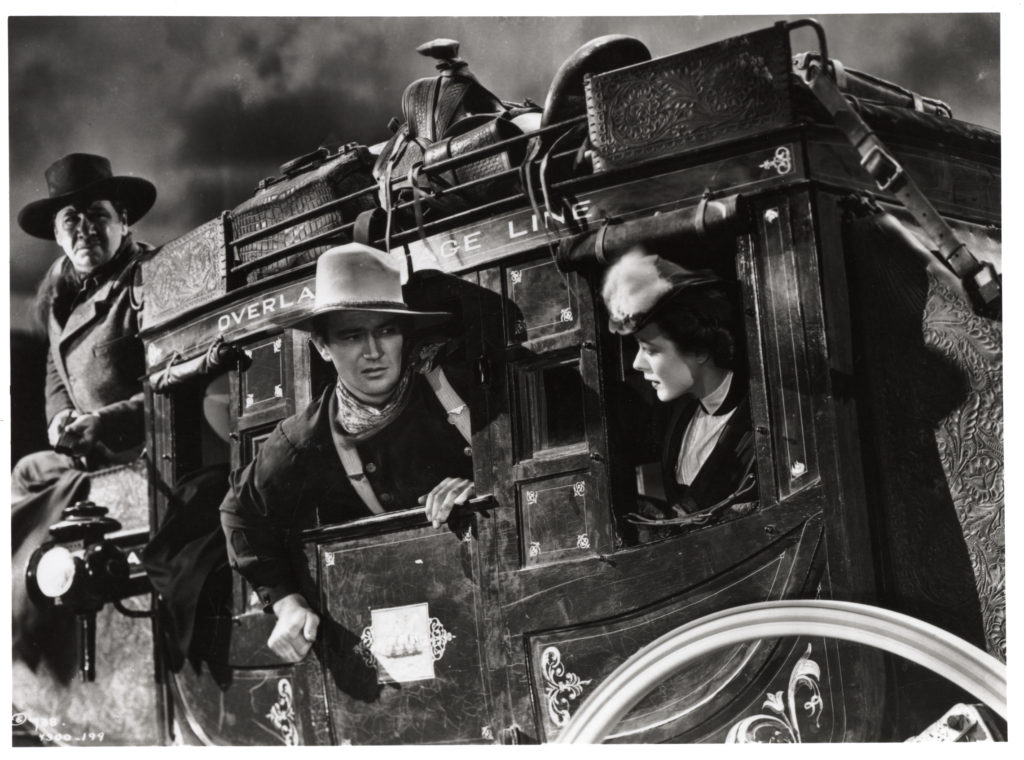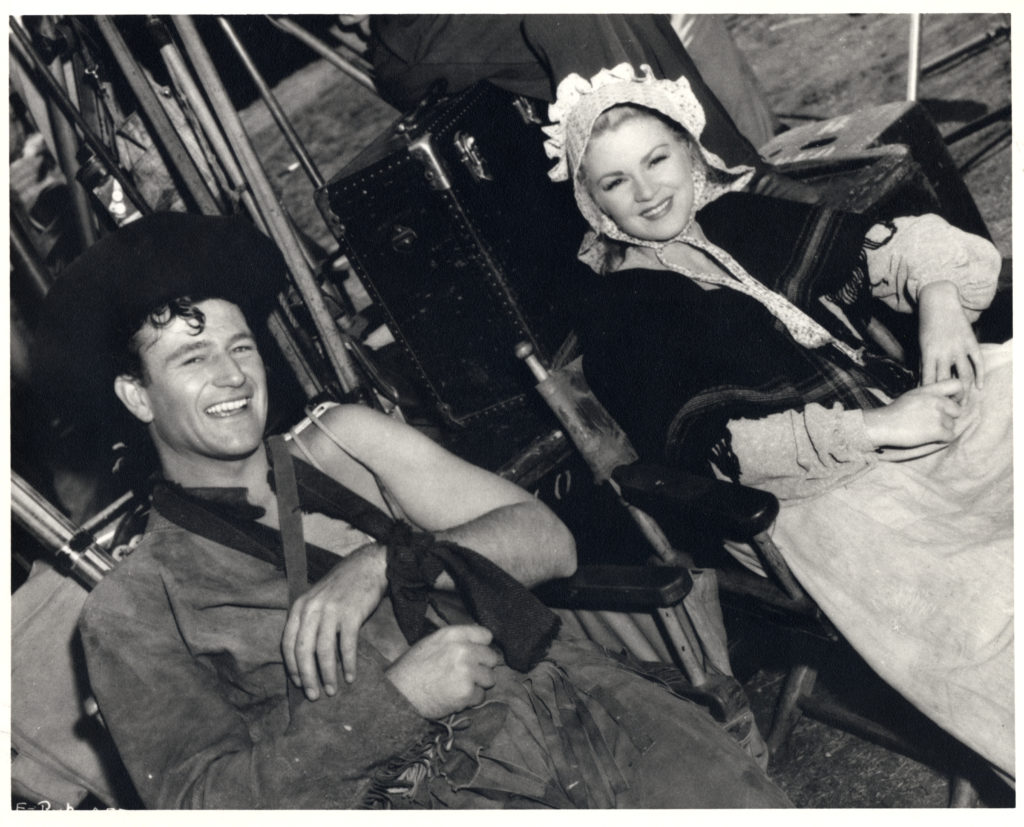
Presenting a new kind of movie—and star—to the world, John Ford’s genre-busting classic still thrills at 86.
Written by Constance Dunn
John Ford’s Vision: A Genre-Defining Gamble
“He’ll be the biggest star ever,” John Ford said quietly on the set of a big-budget Western he was shooting. He was referring to his leading man, John Wayne, with whom the director was taking a daring gamble in this new picture.
Ford hadn’t directed a Western since the silent days, and the studios were not keen on funding a big-budget one, particularly since the genre was hardly in vogue in the late-1930s. Neither were they impressed with Wayne, a B-picture actor who had been kicking around Hollywood for more than a decade.
Studio Resistance and Ford’s Determination
Nonetheless, the director turned down the backing of major studios on their insistence that Wayne be replaced with someone more A-list. Ford eventually partnered with independent producer Walter Wanger to fulfill his firm vision for this movie—which would end up catapulting him into the league of legendary film directors, turn Duke into a household name and transform the Western, if not American narrative film itself.
Casting Challenges and Ford’s Unwavering Vision
As for casting, it’s hard to imagine Stagecoach without John Wayne. Even producer Wanger wanted someone else for the lead—Gary Cooper. John Wayne wasn’t even Wayne’s first choice. Ford, who had known Duke since his earliest days in Hollywood, asked the actor who he’d recommend playing the lead in a new movie he was developing. It was to be based on the short story, “Stage to Lordsburg,” which the popular Western scribe Ernest Haycox had published in a 1937 issue of the popular magazine Collier’s.
John Wayne’s Breakthrough: The Performance That Changed His Career
Wayne demurred and recommended the actor Lloyd Nolan, who had recently appeared in a King Vidor-directed movie, The Texas Rangers. To which Ford responded: “Hell, Duke, can’t you play it?”
Billed as a “Powerful Story of 9 Strange People,” the film would gather a fantastic tale of transformation, love, vengeance, and seat-gripping action-adventure under the majestic landscape of Monument Valley. It would also present Duke in all his glory—showcasing every hour he had spent during the last decade gaining mastery of his craft, whether in the realm of stunts, costuming, expression or riding a horse and shooting a gun.
A Star-Making Performance: Ford’s Vision for Wayne
All of which he did with the seemingly effortless mix of charisma and ease that is the elusive hallmark of stardom. Ford certainly presented John Wayne in Stagecoach as a star, starting with Duke’s first appearance in the film. We are introduced to his Ringo the Kid in grand fashion—the dolly rushing up to the commanding, 6’4” Wayne holding onto a saddle in one hand and twirling a cocked Winchester with the other.
John Ford’s Tough Approach to Directing Wayne
If Ford knew this film would be the one for Wayne, however, he certainly didn’t share it with the man he called Duke, and who in return Wayne referred to as Coach, Pappy, or Jack. Ford was known to be hard on his protege at work. His on-set proclamation about Wayne becoming the biggest star in the world, for instance, came directly after he had told Wayne “he acted like a poached egg and walked like a hippo,” according to the book Duke in His Own Words, based on the actor’s private archives.
The Audience’s Reaction to Stagecoach
So, it’s not surprising that Wayne, sitting in the audience for the first preview of the film in Westwood, California, was fairly bowled over by its reception. “I had never in my life seen anything as exciting,” the star would later write. “The way those kids took to the picture was tremendous. They laughed, clapped, stomped, and obviously loved it.”
“The way those kids took to the picture was tremendous. They laughed, clapped, stomped, and obviously loved it.”
John Wayne
The Lasting Legacy of Stagecoach
The rest of the American movie-going public responded in kind. Stagecoach was released on March 2nd, 1939, and was a colossal hit. It received seven Academy Award nominations, buoyed the Western genre to respectability and made stars of its director and male lead, while also elevating the careers of several of its main cast. Its place fixed in the annals of all-time great films, it’s still studied, analyzed, and talked about today—all due to a gutsy risk taken by a persistent Ford over 85 years ago that still transfixes audiences today.

John Wayne with his co-star Claire Trevor behind the scenes on the set of “Stagecoach.” Photograph courtesy of the John Wayne Archive.
Stagecoach: Watch, Own, Explore
Your complete guide to experiencing this legendary Western.
Where to Watch
- Streaming: Available on HBO Max, Criterion Channel, and Amazon Prime Video.
- Rental & Purchase: Stream or download on Apple TV, Fandango, and YouTube Movies.
- Special Screenings: Check local theaters and classic film festivals for screenings of Stagecoach on the big screen.
Own the Movie
- Collector’s Editions & Blu-ray: Find beautifully restored versions at Criterion Collection, Amazon, and Barnes & Noble.
Read More
- Behind the Scenes: Explore the making of Stagecoach in books like John Ford: The Man and His Films or Stagecoach: The Classic Film and Its Legacy.
- John Wayne’s Legacy: Dive into JohnWayne.com for stories, memorabilia, and more.
Shop the Stagecoach Collection
Celebrate the legacy of Stagecoach with exclusive apparel and collectibles from the Stagecoach Anniversary Collection at John Wayne Stock & Supply.


